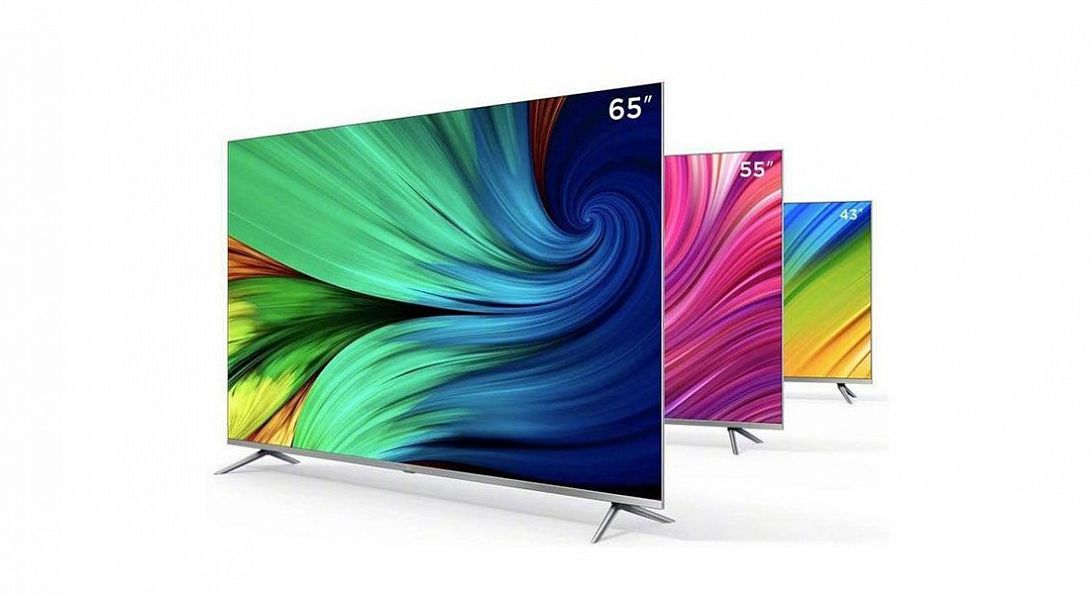No one is surprised now by the presence of TV in the house. Nevertheless, a quality device with interesting features and an attractive design is able to attract the attention of guests. Now we will try to figure out in as much detail as possible how to choose a TV for home in 2020, so that it matches the price-quality ratio.
The variety of models significantly complicates the choice and making the final decision as to which is the best TV to buy so that it is inexpensive and good. Large or compact, strict or curved, Smart or simple? All of these features and more are essential if you want to make a bargain.
Content
How to choose a TV for your home - expert advice
Budget

As we all understand, the purchase of a TV largely depends on how much money you are going to spend on the purchase, and only then think about which TV is better to choose, cheap without bells and whistles or expensive with different modern chips. You don't have to spend hundreds of thousands to buy a great quality device with a full range of features. The TV's value for money should be justified. At the same time, remember - the cheapest equipment has the worst quality and fewer functions. Since technology is developing quite quickly, it is best to spend a little more money on the purchase and enjoy using TV for more than one year.
Most Popular Panel Technologies Today

For a clearer picture, we will look at several of the most modern technologies for making TV panels. We will reveal the advantages and disadvantages of each technology, so that when choosing an inexpensive, but good TV for the home, you understand which technologies you need to look at, so that the picture, sound and perception of the content in general are much better and more pleasant. These include liquid crystal display and organic light emitting diodes (OLED). We did not consider CRTs since this technology is no longer popular and is becoming a thing of the past.
LCD display
Almost 90% of devices are equipped with liquid crystal technology - LED LCD. Due to its presence, the models consume a little electrical energy, and also differ in a thin display and low weight - you can buy such a TV in the bedroom. For the production of equipment of the liquid crystal type, a minimum of resources and other costs are required - this is another reason for their prevalence. All the advantages of this technology make it possible to choose any model - budget, expensive or mid-range. LCD also has weaknesses, for example, the use of white LEDs as a backlight.
Pros:
- diverse lineup
- small thickness
- excellent brightness
- affordable cost
Minuses:
- insufficient contrast ratios
- narrow viewing angles
Organic LEDs

Unlike LCD, OLED technology is new. In such models, there is no backlight unit, since there is no need for it - the device is equipped with a panel consisting of organic LEDs. As a result, each of them acts as a light source. OLED models are even thinner than LCDs. The picture quality, contrast level, saturation and realism are also noticeably improved. The only drawback of these TVs is the high price, which is also associated with a small range of OLED equipment on sale.
Pros:
- natural image
- high contrast
- depth
- wide viewing angles
- excellent color rendering
Minuses:
- price
- small selection
There is a kind of golden mean between these two technologies - LED display. It is of higher quality, thinner, better LCD and, accordingly, more expensive, although many times more affordable compared to new OLED products.
If you intend to purchase the highest quality TV and are ready to spend a considerable amount, and the choice is between an LCD or an ice TV, be sure to buy a model with LED technology.
Choosing a TV according to important criteria
As you understand, there are a lot of characteristics in modern TVs, of course we will not consider all of them, but we will talk about the main criteria that you should pay attention to when choosing a reliable TV for your home. When making a purchase, it is important to take into account several technical characteristics that will help you not to make a mistake in choosing high-quality, multifunctional equipment.
Diagonal size
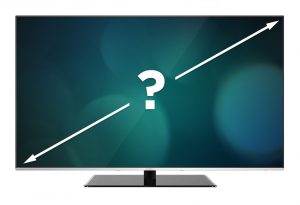
The first thing you should pay attention to is the diagonal. To choose the right TV diagonally, remember - this indicator is measured in inches, and the parameters of the models vary in the range of 19-110 inches. Which model should you buy? According to the advice of experts, the size of a television panel should be 4-5 times smaller than the distance from it to the viewer's location. Due to this, you will be much more comfortable looking at the display, moreover, with this combination, there is less stress on vision. Therefore, if you want to choose a good TV for the living room or hall, measure the distance at least approximately and make the appropriate calculations.
You also need to consider why you are buying equipment. If the TV will be used for games and watching football, then in this case it will not be limited to a small display - the image must be large and clear.
If you buy a device for the kitchen, then it is better not to take a 32-inch diagonal, but to give preference to more compact models with the ability to mount on the wall. For a bedroom or living room, according to numerous user surveys, a screen diagonal of 43 to 55 inches is ideal.
Resolution
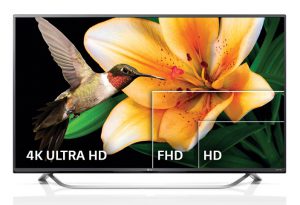
First, you need to understand the concept of "resolution". It means the size of the picture on the screen, measured in pixels. The higher the number, the clearer and better the image looks. It is imperative that the correct combination of diagonal and resolution is maintained. For example, if you decide to choose a TV model with 4K (Ultra HD), then according to the advice of experts, such a resolution is preferable in devices with a diagonal exceeding 32 inches, since on a small diagonal it simply will not give the desired effect.
Common options today:
- HD (1280 by 720 or 1366 by 768 pixels) - small budget models
- Full HD (1920 x 1080) - the most popular and demanded medium-sized devices with good picture quality at an affordable price
- Ultra HD (4K) (4096 x 2160 or 3840 x 2160) - quite expensive, but large models with high quality images
- Ultra HD (8K) (7680 to 4320) - the most expensive options for equipment that are not yet available in a wide variety
When buying a TV, give your preference to Full HD or more modern UHD (4K) resolution, they are the most popular nowadays.
We invite you to watch an interesting video about the possibilities of Ultra HD resolution
Format
Format in other words is the aspect ratio.Previously, displays with sides of 4: 3, that is, models of a square shape, were popular. Nowadays, there are many more widescreen TVs in stores, which have a 16: 9 or 16:10 aspect ratio. It is recommended to give preference to such models for several reasons. Firstly, programs and films are created just for this format, so it is more comfortable to watch them, as they look nicer on the display. Secondly, this ratio is perceived better by vision.
Screen shape
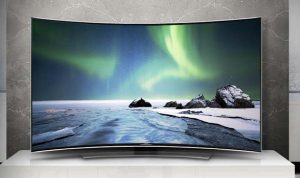
In the form of the display, classic straight devices are most often found. However, manufacturers are developing and manufacturing more and more curved TVs. It turns out that such an original form is intended not only for an interesting design solution. Thanks to the curved shape, it is possible to achieve the highest quality - this has been proven by many experts. Curved models also appear larger visually. In addition, feedback on TVs on the forums testifies to the improved perception of the content that is shown on the curved display. However, the cost of such models is higher, so you can always find an alternative among traditional devices.
Viewing angle
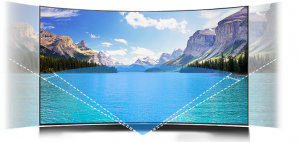
The viewing angle of a TV is a particularly significant parameter, representing the width of the angle within which the shades and the picture as a whole are not distorted on the display. By choosing a TV with a good viewing angle, you will be able to watch it not only sitting directly opposite the display, but also from the side. The best way to check if the angles are good enough is to look at the screen from different angles. If you can't do this, you can find out the technical properties of the model: 176-180 degrees is an excellent indicator.
Brightness and contrast
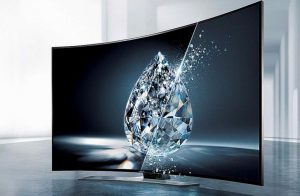
It is not technical properties that will help you choose the right TV in terms of brightness, but the visual perception of the picture. As a rule, in order to allow potential buyers to compare the picture quality on different models, the same content is launched in electronics stores on all TVs. If it seems too dark to you, or, on the contrary, white predominates, it is better to refuse such a purchase. A device with the correct brightness and contrast displays a picture with light whites and deep darks - such an image looks harmonious.
Don't rely on vendor honesty. Often in budget models, the maximum brightness is specially set, while expensive branded devices operate at 50% of the maximum value. This is done in order to sell cheap equipment for which there is no demand. It is enough just to look at the TV settings to expose this deception.
Good brightness is very important. It depends on it how quickly and strongly the eyes will get tired. Especially if you are going to put the TV in a children's room, you should take care of this characteristic.
Response time
According to such parameters and characteristics of the TV as the response time, you can find out how well the display will display the picture. The lower this figure, the better. When purchasing a new model, you don't have to worry about this indicator, since in new devices it is always no more than 5 ms. On older devices, response times can be much higher, which negatively affects the quality of the content. The higher it is, the slower the frame change takes place. The maximum response time should be no more than 10 ms, but if you want to use the TV for gaming purposes, then 5-8 ms is the best indicator.
Refresh rate index
The refresh rate index determines how well dynamic scenes are reproduced on the screen. You may be familiar with the unpleasant flickering effect of older 50Hz TVs. This means that their given index was too low. According to the advice of experts, the TV for image quality should show a maximum of frames per second, for example, 100 Hz and above.The new models use special proprietary technologies, thanks to which it is possible to artificially increase the refresh rate and thereby improve the quality of content perception for the viewer. Thanks to these technologies, fast scenes look as realistic and effective as possible.
Advice! If you like watching movies with dynamic scenes, then give preference to TVs with a refresh rate of at least 200 Hz, although in some manufacturers this figure can reach 1200 Hz.
Sound
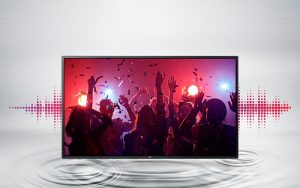
The purity of the sound depends on how comfortable you will be watching movies or ordinary television. As a rule, the larger and more expensive the equipment, the better its sound. To choose a TV with good sound, it is recommended to pay attention to models with Dolby Digital - this is an excellent built-in sound decoder that improves its quality. Of course, it can only be found in expensive and medium-priced devices. Pay attention to the surround sound function, it will give more realistic effects. Budget models are significantly inferior in terms of sound. You will not hear extraneous noise, wheezing and other defects, but the sound quality is very different. If it is not possible to purchase a high-end model, there is another way to solve this problem - to acquire a separate speaker system.
Interfaces
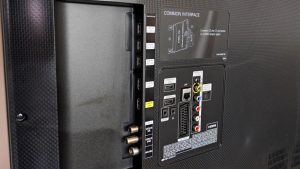
Support for various interfaces implies the ability to connect other devices to the TV. This moment must be thought out before buying the equipment, and already in the process of choosing, it is necessary to clarify the availability of certain functions. However, there is a general list of interfaces that must be present in a device:
- HDMI is a mandatory and quite popular interface now that allows you to connect all kinds of devices to your TV. Carries out the transmission of high-quality image and sound.
- USB - at least 2 ports make it possible to connect adapters, flash drives, etc. to TV.
- DVB-C, DVB-S - supports digital and satellite TV.
- SCART - this interface is optional, since it only works with analog television and is designed to transmit audio and video signals.
- PAL is another optional feature used for analog TV.
- Jack5 - connection of a speaker system or headphones.
- S-Video - transmits an analog signal from a PC.
Choose the rest of the interfaces depending on your needs.
Features that might come in handy

In order to understand how to choose a high-quality TV for your home and not overpay, first of all it is worth giving preference to models only with those functions that you will use. The list is huge, but there are a few basic features that might interest you:
Smart TV - TVs with this function allow you to download programs, use the Internet, watch videos online, that is, use equipment as a computer.
3D - watching movies in three-dimensional mode, like in a cinema. Films must be of proper quality. Special glasses are also required.
HDR - support for this option allows you to view content with more dynamic colors (white becomes brighter, black becomes darker)
Picture in Picture - you can watch two channels at the same time.
Anti-glare coating - when exposed to sunlight, glare does not appear on the display, impairing viewing.
Choosing a TV with Internet and Wi-Fi, you will be able to watch content like on a PC. To access an Internet connection, software is required - for example, Android provides this opportunity. The built-in module is not required - instead, you can buy a special adapter and connect it via USB.
Memory card recognition - slot for microSD (for playing files from a smartphone or camera).
Wall mount - space-saving fastening system. Focus on the area of the room: it is better to hang the TV in a cramped room on the wall.
Which company is better to buy a TV

Once the technical characteristics and the necessary features are selected, it remains only to decide which TV company to choose. Many manufacturers manufacture equipment in different price categories, so there will be no problems with the assortment. The most popular and reliable companies: LG, Sony, Samsung, Panasonic, Philips, all manufacturers are distinguished by high build quality and the presence of the most modern technology, especially in expensive models.
Rating of the best TVs in 2020
There are tons of TVs out there, from cheap ones for the bedroom or kitchen to larger-screen devices with cool 3D bells and whistles, smart TVs and 4K. There are hundreds of models from which you can and should choose! And so that you do not have to revise all possible devices, our team has prepared for you a ready-made rating of the best TVs for 2020, according to numerous expert assessments and customer reviews on the Internet.
- OLED LG OLED55B9P
- Xiaomi Mi TV 4S 43 T2
- LG 55UM7300
- NanoCell LG 55SM8600
- Samsung UE50NU7002U
- OLED LG OLED65C9P
How to choose a TV by parameters and characteristics
When you know about the capabilities of TVs, their technical parameters, you can safely go shopping in the store. Remember that consultants do not always evaluate equipment objectively, because their task is to sell a product. However, now you yourself know how to choose an inexpensive TV for home, so that it is good, of high quality and performs the required functions. It is not difficult to make a profitable purchase, the main thing is to listen to your feelings and remember the recommendations we have given.

